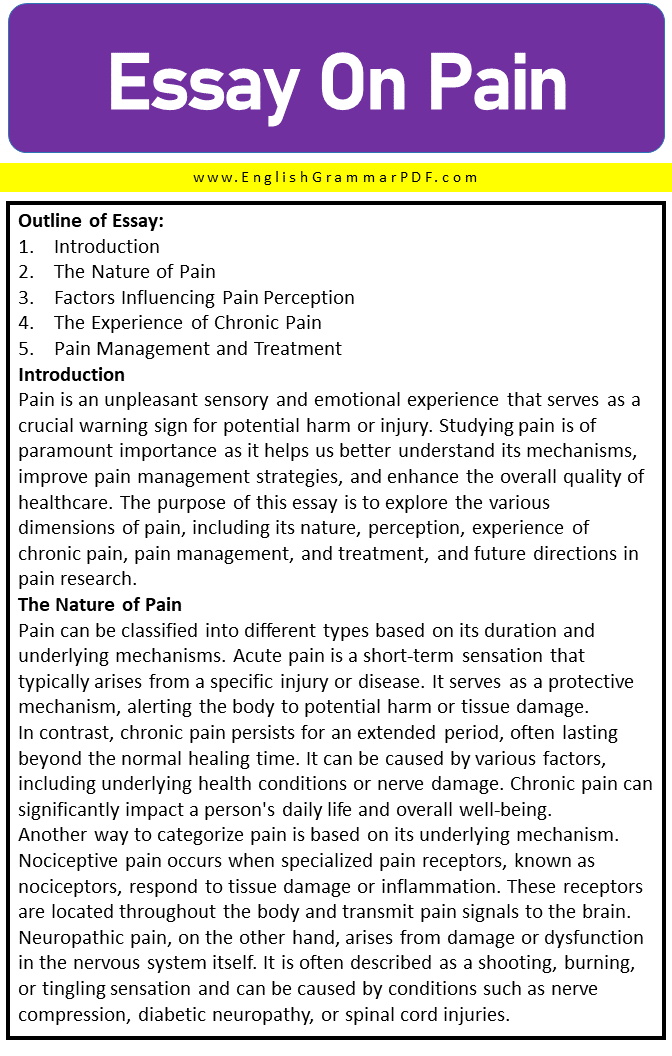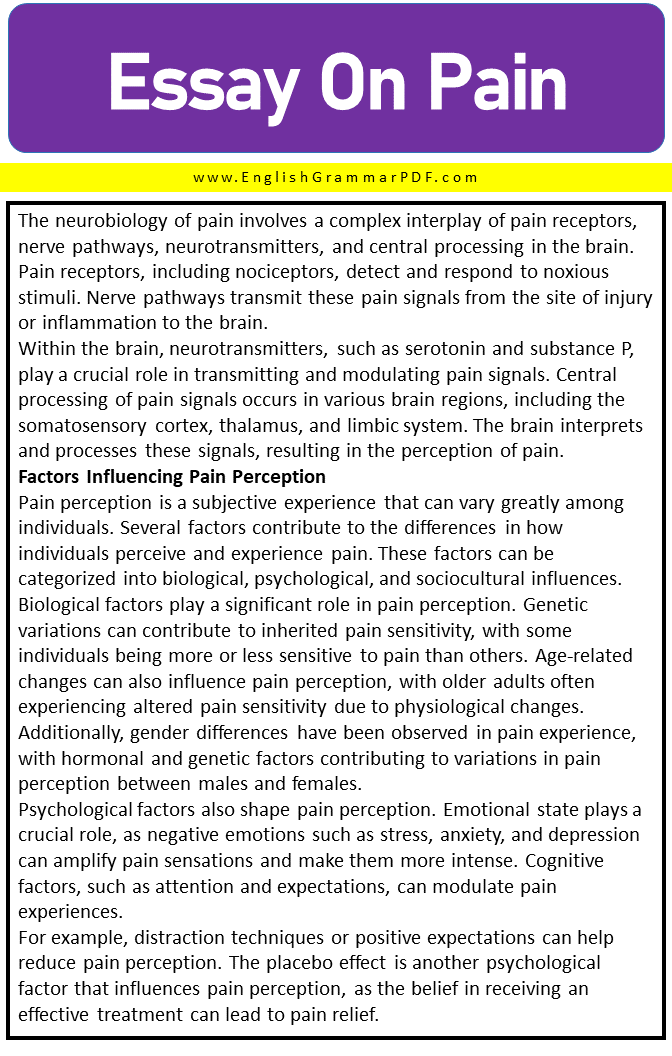Essay On Pain
Outline of Essay:
- Introduction
- The Nature of Pain
- Factors Influencing Pain Perception
- The Experience of Chronic Pain
- Pain Management and Treatment
Introduction
Pain is an unpleasant sensory and emotional experience that serves as a crucial warning sign for potential harm or injury. Studying pain is of paramount importance as it helps us better understand its mechanisms, improve pain management strategies, and enhance the overall quality of healthcare. The purpose of this essay is to explore the various dimensions of pain, including its nature, perception, experience of chronic pain, pain management, and treatment, and future directions in pain research.
The Nature of Pain
Pain can be classified into different types based on its duration and underlying mechanisms. Acute pain is a short-term sensation that typically arises from a specific injury or disease. It serves as a protective mechanism, alerting the body to potential harm or tissue damage.
In contrast, chronic pain persists for an extended period, often lasting beyond the normal healing time. It can be caused by various factors, including underlying health conditions or nerve damage. Chronic pain can significantly impact a person’s daily life and overall well-being.
Another way to categorize pain is based on its underlying mechanism. Nociceptive pain occurs when specialized pain receptors, known as nociceptors, respond to tissue damage or inflammation. These receptors are located throughout the body and transmit pain signals to the brain.
Neuropathic pain, on the other hand, arises from damage or dysfunction in the nervous system itself. It is often described as a shooting, burning, or tingling sensation and can be caused by conditions such as nerve compression, diabetic neuropathy, or spinal cord injuries.
The neurobiology of pain involves a complex interplay of pain receptors, nerve pathways, neurotransmitters, and central processing in the brain. Pain receptors, including nociceptors, detect and respond to noxious stimuli. Nerve pathways transmit these pain signals from the site of injury or inflammation to the brain.
Within the brain, neurotransmitters, such as serotonin and substance P, play a crucial role in transmitting and modulating pain signals. Central processing of pain signals occurs in various brain regions, including the somatosensory cortex, thalamus, and limbic system. The brain interprets and processes these signals, resulting in the perception of pain.
Factors Influencing Pain Perception
Pain perception is a subjective experience that can vary greatly among individuals. Several factors contribute to the differences in how individuals perceive and experience pain. These factors can be categorized into biological, psychological, and sociocultural influences.
Biological factors play a significant role in pain perception. Genetic variations can contribute to inherited pain sensitivity, with some individuals being more or less sensitive to pain than others. Age-related changes can also influence pain perception, with older adults often experiencing altered pain sensitivity due to physiological changes. Additionally, gender differences have been observed in pain experience, with hormonal and genetic factors contributing to variations in pain perception between males and females.
Psychological factors also shape pain perception. Emotional state plays a crucial role, as negative emotions such as stress, anxiety, and depression can amplify pain sensations and make them more intense. Cognitive factors, such as attention and expectations, can modulate pain experiences.
For example, distraction techniques or positive expectations can help reduce pain perception. The placebo effect is another psychological factor that influences pain perception, as the belief in receiving an effective treatment can lead to pain relief.
Sociocultural factors influence how individuals perceive and express pain. Cultural variations exist in pain expression, tolerance, and response to pain management interventions. Social support and coping mechanisms can impact pain perception, as having a strong support system can help individuals better cope with pain. Socioeconomic status also plays a role, as individuals with limited resources may face barriers to accessing appropriate pain management treatments.
The Experience of Chronic Pain
Chronic pain is a debilitating condition that significantly impacts the lives of millions of individuals worldwide. Unlike acute pain, which serves as a warning sign of injury or illness, chronic pain persists for an extended period, often lasting beyond the normal healing time. The experience of chronic pain goes beyond physical discomfort and can have profound consequences on various aspects of a person’s life.
One of the defining characteristics of chronic pain is its ability to impair the quality of life and daily functioning of individuals. It can restrict their ability to perform routine activities, such as walking, lifting, or even engaging in hobbies and social interactions.
Chronic pain can lead to decreased mobility, affecting independence and overall well-being. The constant presence of pain also has a significant impact on sleep patterns, contributing to fatigue and decreased energy levels.
Furthermore, chronic pain has substantial emotional and mental health implications. It is associated with higher rates of depression, anxiety, and decreased overall psychological well-being. The constant suffering and limitations imposed by chronic pain can lead to feelings of frustration, helplessness, and hopelessness. It can also strain relationships with family, friends, and coworkers, as individuals with chronic pain may find it challenging to participate in social activities or fulfill their interpersonal responsibilities.
Pain Management and Treatment
Pain management and treatment encompass a range of approaches aimed at alleviating pain and improving the overall well-being of individuals. There are various strategies available, including pharmacological and non-pharmacological interventions, each tailored to address different types and severities of pain.
Pharmacological interventions play a central role in pain management. Non-opioid analgesics, such as NSAIDs, are commonly used for mild to moderate pain relief. They work by reducing inflammation and blocking pain signals.
However, opioids, despite their effectiveness in managing severe pain, have significant risks associated with them, including addiction and overdose. Thus, their use is carefully monitored and reserved for specific cases. Additionally, emerging therapies and alternatives, such as nerve blocks, topical analgesics, and medical cannabis, are being explored as additional options for pain relief.
Non-pharmacological interventions are essential components of comprehensive pain management. Physical therapy and rehabilitation help improve function, mobility, and reduce pain through targeted exercises, stretching, and other modalities.
Psychological approaches, like cognitive-behavioral therapy (CBT), assist individuals in managing pain-related thoughts, emotions, and behaviors. Complementary and alternative medicine practices, including acupuncture, massage, and yoga, have gained recognition for their potential to alleviate pain and promote relaxation.
Ethical considerations are crucial in pain management. Balancing the need for pain relief with potential risks, such as addiction and side effects, requires careful consideration and monitoring. The opioid crisis has prompted healthcare providers to adopt responsible prescribing practices and emphasize multimodal approaches to pain management. Respecting patient autonomy and involving them in shared decision-making empowers individuals to actively participate in their pain management plan.
FAQ’s
Why is pain important in life?
Pain is important in life as it serves as a crucial warning signal for potential harm or injury, prompting us to take necessary actions to protect ourselves and maintain our well-being.
How can pain change your life?
Pain can significantly impact one’s life by limiting daily activities, affecting physical and mental health, straining relationships, and altering the overall quality of life. Chronic pain, in particular, can lead to long-term changes in various aspects of life.
Is pain necessary for happiness?
While pain is an inevitable part of the human experience, it is not necessary for happiness. Happiness can be achieved through a variety of positive experiences, relationships, personal growth, and finding meaning and purpose in life. Pain and happiness are separate but interconnected aspects of the human emotional spectrum.
Download the PDF of the Essay:
Explore More Essays:







